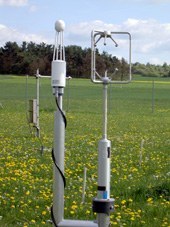Ozone, CO2 and energy incl. water vapour
- Ozone, CO2 and energy incl. water vapour-3
-
The exchange of trace gases, latent and sensible heat and aerosol constituents between the atmosphere near the ground and the phytosphere is controlled by complex interactions of meteorological and biological processes.
During the last decades several micrometeorological methods for quantifying energy and trace gas exchange have been developed. Important measurement techniques are:
- eddy covariance technique
- aerodynamic profile method
- (modified) Bowen ratio-energy balance method
Alternatives methods are the conditional sampling or relaxed eddy correlation technique, the inertial dissipation method and the variance technique.
- Ozone, CO2 and energy incl. water vapour-4
-
 If a vertical flux density F measured in the atmospheric surface layer at some reference height above the canopy shall reflect the exchange at the surface, the atmospheric surface layer must satisfy the conditions of the so-called 'constant-flux layer'.
If a vertical flux density F measured in the atmospheric surface layer at some reference height above the canopy shall reflect the exchange at the surface, the atmospheric surface layer must satisfy the conditions of the so-called 'constant-flux layer'.From the general budget equation for trace gases one can deduce that the desired constant-flux situation is met if all of the following postulates shown here are satisfied:
- stationarity, that means the change of the meteorological variable with time is zero
- horizontal homogeneity of the plant/soil system (fetch problem)
- no horizontal advection
- no chemical sources and sinks between the reference height and the surface
- zero mean vertical wind velocity
If all these postulates are met, the general budget equation is reduced to the eddy covariance equation. The eddy covariance technique is the most elegant of the micrometeorological methods.
There are several gradient methods, that are currently used to assess the vertical turbulent flux of ozone. These methods rely on the relationship between turbulent fluxes and vertical time averaged gradients. The methods differ in how the gradients are used to obtain the flux. The methods based on the aerodynamic profile method or at the modified Bowen-ratio method.
Because the before mentioned postulates are never fully satisfied, several corrections and quality tests are necessary to guarantee flux data sets of high accuracy.
A description of micrometeorological measurement techniques and the basic assumptions can be found in e.g.:
Grünhage, L., Haenel, H.-D. & Jäger, H.-J. (2000): The exchange of
ozone between vegetation and atmosphere: micrometeorological
measurement techniques and models. Environmental Pollution 109,
373-392.A comprehensive discussion of the correction procedures can be found e.g. in:
Lee, X., Massman, W. & Law, B. (2004): Handbook of micrometeorology.
A guide for surface flux measurement and analysis. Dordrech: Kluwer.

